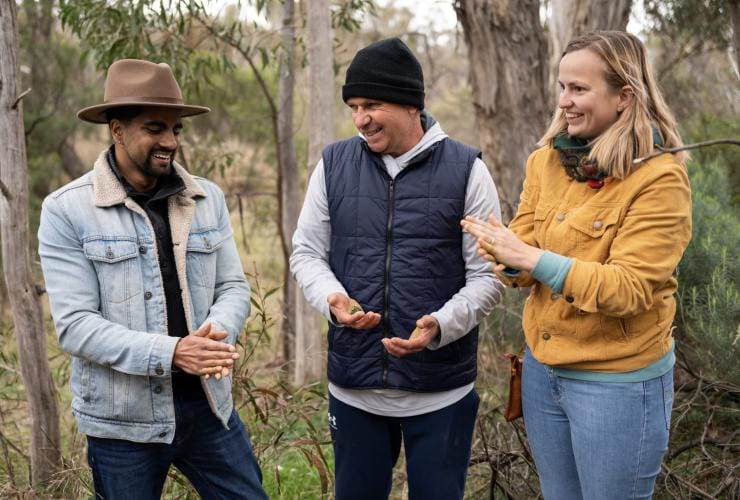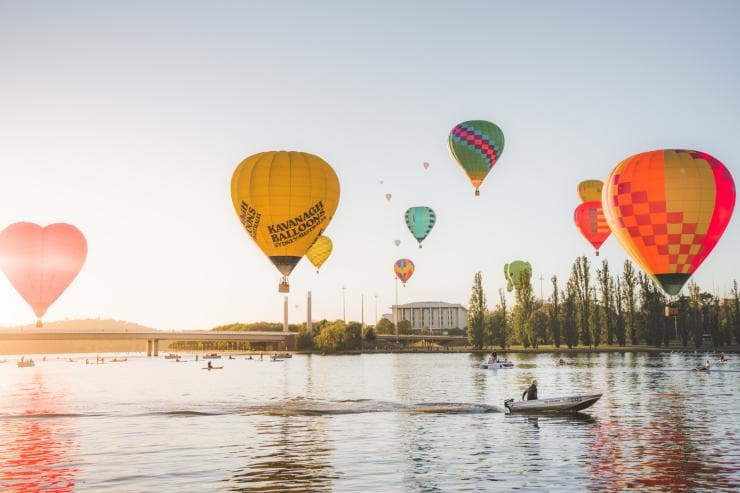
Tidbinbilla Nature Reserve, Canberra, Australian Capital Territory © Stuart Miller
Experience Aboriginal culture in Canberra
A selection of guided Aboriginal tours can show you around significant cultural sites in the Canberra region.
By Paul Robinson
There are many significant Aboriginal sites in the Canberra region and many stories to tell, but if you want a deep understanding of them, you'll need some insider knowledge.
Immerse yourself in one of Canberra’s many Aboriginal experiences and get a unique perspective into this fascinating local culture. Learn about the customs and traditions of the Ngunawal people on specially guided tours where you’ll find hidden rock art and historical artefacts, learn about “bush food” and traditional stone tools and hear the stories of the significant sites you visit.
Mount Majura two-hour tour

Dharuwa Tours, Canberra, Australian Capital Territory © Tourism Australia
Mount Majura is part of the Canberra Nature Park, which lies on the north-eastern edge of the city. At 888 metres (2,913 feet), it is the highest peak in suburban Canberra, mostly covered in eucalyptus trees, and home to 12 known culturally and archaeologically significant Aboriginal sites. On this two-hour Dhawura Aboriginal Cultural Tour, you’ll learn about the mountain’s importance to Aboriginal people and the wide range of wildlife that lives here (including several threatened species), identify and sample bush foods, and learn about the traditional uses of various tools. Perhaps you’ll even discover a “scar tree”, where the bark was once removed to create containers, shields or even canoes, leaving historical scars. The view of Mount Majura valley below is a fitting reward for the climb in itself.
Cultural sites in Canberra half-day tour

Red Hill Lookout, Canberra, Australian Capital Territory © VisitCanberra
Hop into a 4WD troop carrier for a 3.5-hour driving adventure with this Dhawura tour, which will take you to several important locations that show abundant evidence of Aboriginal occupation in the Canberra area. Highlights include the bush food sites in Red Hill and “grinding grooves” in the suburb of Theodore. These grooves are the result of the Aboriginal practice of shaping and sharpening new stone axe heads on the rock, creating oval indentations in local sandstone that have existed for many centuries. You will also see both a canoe tree and shield tree near Lanyon Homestead, where bark was ripped from the trees to construct the objects, leaving scarring behind.
Ngala Tours

Ngala Tours, National Arboretum, Canberra, Australian Capital Territory © Tourism Australia
At the National Arboretum Canberra, you can join Ngala Tours for a leisurely afternoon spent strolling the expansive gardens, spying treasures amid the foliage and learning about the area's rich Aboriginal history. As you wander between the property's diverse flora, a true highlight will be the breathtaking lookouts across forests, gardens and Lake Burley Griffin. Pack a picnic to continue exploring the arboretum at your own pace once the tour concludes.
Namadgi National Park full-day 4WD tour

Dharuwa Tours, Canberra, Australian Capital Territory © Tourism Australia
If you’ve got a bit more time to spare, consider the full-day 4WD Dhawura Tour through Namadgi National Park, which makes up almost half the entire land area of the Australian Capital Territory. Aboriginal occupation of the area has been dated to at least 21,000 years here, and there are many historical cultural sites – both Aboriginal and European – in the park. Forage for bush foods, spot wildlife, witness Aboriginal artefacts and hear many cultural stories. You’ll gain an appreciation for the significance of the area to the local Ngunawal people and receive a detailed Aboriginal interpretation of the landscape from your experienced guide. This tour is recommended for families with older children and runs seasonally, from September through to the March.
Feel inspired through Aboriginal art

National Gallery of Australia, Canberra, Australian Capital Territory © Martin Ollman / Tourism Australia
The art of the Aboriginal and Torres Strait Islander peoples is among the oldest and richest in human history. Expressed through dance, song, textiles, rock engravings, body painting, and paintings, art plays a significant role in the everyday lives of First Nations people and conveys their connection to the land. Well worth visiting is the National Gallery of Australia, which is home to the world’s largest collection of more than 7,500 diverse works of Australian Aboriginal and Torres Strait Islander art.
For original, handcrafted arts and crafts and exhibitions featuring local Aboriginal artists, head to Burrunju Art Gallery. This not-for-profit gallery showcases established and emerging independent Aboriginal artists where you can also partake in a dot painting workshops. Additionally, the Aboriginal Dreamings Gallery is a commercial gallery with an extensive collection of Indigenous art, gifts and jewellery which can be viewed and purchased from its gallery in Gold Creek Village, or sister gallery Artworld ADG in the city centre.
Embark on a self-drive heritage trail adventure

Tidbinbilla Nature Reserve, Canberra, Australian Capital Territory © Stuart Miller
Choose your own adventure and go at your own pace with a self-drive tour through Ngunnawal Country with Canberra Tracks. Journey through this scenic area which served as a meeting place for the Ngunnawal people. Stop off at significant sites and points of interest along the way to learn the Aboriginal story of the nation’s capital and feel a sense of connection to its past, present and future. One of the highlights includes Tidbinbilla Nature Reserve, where you’ll find the oldest known inhabited rock shelter, dating back to the end of the last ice age more than 25,000 years ago. If you have the time, join an Aboriginal ranger on a guided walk through the park to see several places of cultural sacredness, Aboriginal artefacts and wildlife.
Read next
6 ways to enjoy Canberra’s Lake Burley Griffin
Immerse yourself in Aboriginal past and present

National Museum of Australia, Canberra, Australian Capital Territory © Tourism Australia
Displayed over two floors, the First Australians gallery is the National Museum of Australia’s largest exhibition. It shares the stories of Aboriginal and Torres Strait Islander peoples, exploring powerful issues. Learn about defining historical moments through digital interactives, sensory displays, and fascinating collections of art, craft and artefacts.
At Parliament House, the daily ‘Yeribee’: Indigenous experiences tour offers a unique insight into how First Nations peoples have brought about change through their roles in the nation’s democratic processes. The tour is free but must be booked in advance. Another historically significant site is the Aboriginal Tent Embassy, located opposite the Museum of Australian Democracy. First established in 1972 to protest the government’s approach to Indigenous Australian land rights, it remains as a permanent protest occupation site representing the political rights of First Nations peoples. Take the chance to open a dialogue with the activists.





























































































































